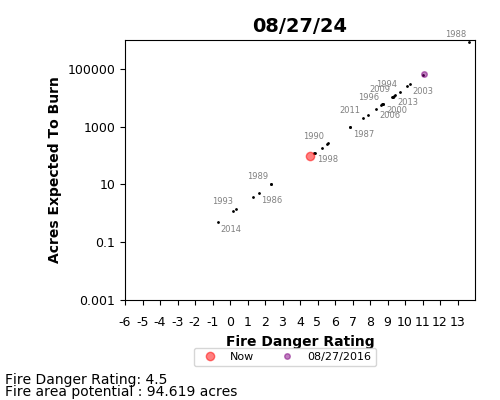

|
|
Current Temperatures in Degrees
Fahrenheit
|
| Mammoth |
Tower |
Old
Faithful |
S. Entrance |
Livingston
|
Gardiner |
Estimated Fire Potential | KBDI and THRFM |
Park Wide |
Quadrant Mtn Mammoth |
 Fire potential is estimated with an elastic net linear regression that uses 83 predictor variables derived from a water balance model that has been applied to weather data collected from 15 different weather stations (more info on these methods here). Bootstrap tests show that the climatic factors considered by this regression explain about 80% of the variance in historical fire size in Yellowstone. Black dots on the graph above show the total acres burned in Yellowstone during selected years. The Keetch-Byram Drought Index (KBDI) measures the likelihood of fire spread based on the moisture content of deep soil and duff layers. It ranges from 0 (no drought) to 800 (extreme drought) and is based on an assumed soil water holding capacity of 8 inches (800 hundreths of an inch) of water. The depth of soil required to hold 8 inches of moisture varies. A KBDI of 300, for example, indicates that 3 inches (300 hundreths of an inch) of precipitation would be required to restore soil to full water holding capacity. The KBDI shown in the graph to the right was calculated using methods described here and here. Thousand Hour Fuel Moisture (THRFM) is the percent moisture content, by weight, of dead wood 3 - 8 inches in diameter. THRFM can be determined empirically by weighing pre-prepared wood samples in the field. The THRFM shown in the graph to the right is estimated by applying a mathematical algorithm to weather data collected in Yellowstone National Park. Even though the estimates in the graph are not derived empirically, they compare quite well to actual field measurements as shown here. The equations used to estimate THRFM are described here and here. |
|